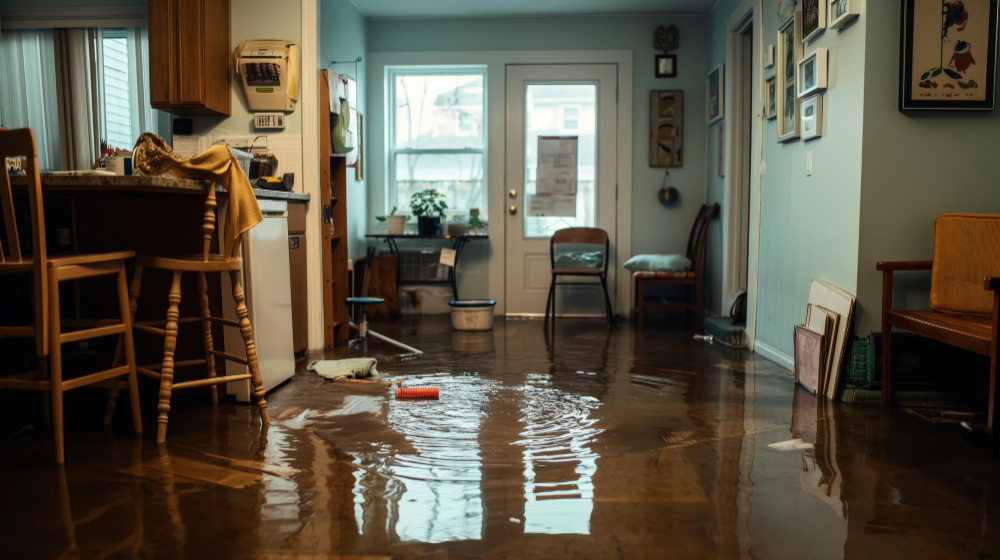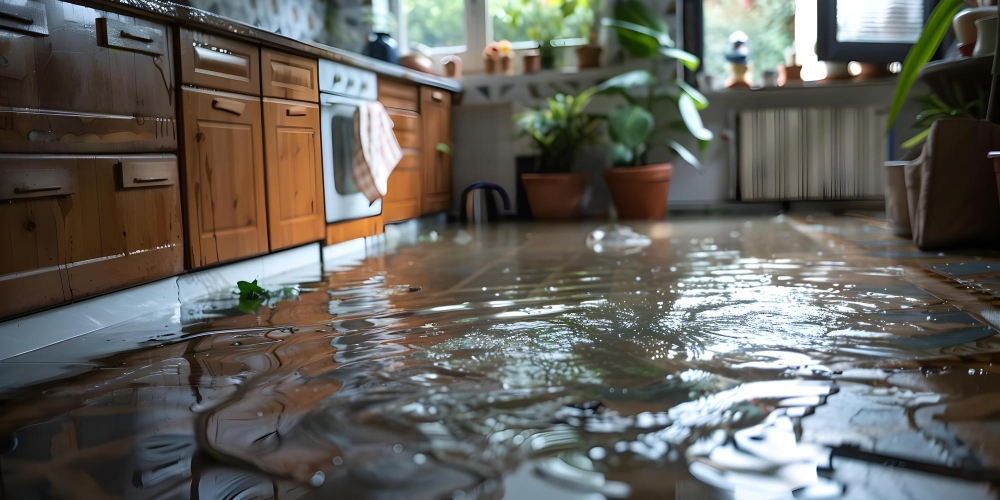Dealing with a flood in your home can be a daunting and overwhelming experience. As the water levels rise, you may find yourself wondering whether to call your insurance company or a water removal service first. Both options can be beneficial, but it’s important to understand the process and make an informed decision.
When it comes to insurance, it’s crucial to act quickly and reach out to your provider as soon as possible. They can guide you through the claims process and help assess the damage. They may also be able to recommend reputable water removal services in your area. However, keep in mind that insurance coverage for water damage can vary, so make sure you understand your policy and its limitations.
On the other hand, hiring a water removal service can expedite the process of removing excess water and drying out your home. These professionals have the expertise and equipment to minimize further damage and prevent mold growth. They can also document the extent of the damage, which can be valuable when you file an insurance claim.
Ultimately, the best course of action may differ based on your specific situation. By familiarizing yourself with your insurance policy and considering the immediate needs of your home, you can make an informed decision on whether to call your insurance or a water removal service first.
Understanding the importance of immediate action during a flood
When a flood strikes, every second counts. The longer the water remains in your home, the more severe the damage can become. Immediate action is crucial to minimize the impact and prevent further destruction. As soon as you notice flooding, it’s essential to take steps to protect your property and personal belongings.
Delaying the response can lead to a range of problems, including structural damage, the growth of mold and mildew, and the contamination of your home’s interior. Water can seep into walls, floors, and furniture, causing them to weaken and potentially collapse. Additionally, standing water provides the perfect breeding ground for harmful bacteria and microorganisms, which can pose a serious health risk to you and your family.
Prompt action is also important for insurance purposes. Most insurance policies have strict timelines for filing claims, and the longer you wait, the more difficult it may be to document the extent of the damage. By acting quickly, you can increase your chances of receiving the full coverage and compensation you’re entitled to, which can be crucial in the aftermath of a devastating flood.
The role of insurance in flood damage coverage
When it comes to dealing with a flood, having the right insurance coverage can make a significant difference in your ability to recover and rebuild. Flood insurance is a specialized type of policy that provides protection against the financial consequences of water damage caused by natural disasters, such as heavy rains, hurricanes, or rising water levels.
It’s important to note that standard homeowner’s or renter’s insurance policies often do not cover flood-related damage. In fact, many insurance companies exclude flood coverage from their standard policies, as the risk of flooding can be quite high in certain areas. As a result, it’s crucial to purchase a separate flood insurance policy to ensure that you’re adequately protected.
Flood insurance policies typically cover the cost of repairing or replacing your home’s structure, as well as the replacement of any personal belongings that were damaged or destroyed by the flood. Some policies may also provide additional living expenses if you’re forced to temporarily relocate while your home is being repaired.
However, it’s essential to understand the limitations and exclusions of your flood insurance policy. For example, some policies may not cover damage caused by sewer backups or groundwater seepage, or they may have caps on the amount of coverage provided for certain types of property. By carefully reviewing your policy and understanding its terms, you can ensure that you’re fully prepared to navigate the claims process in the event of a flood.

When to call your insurance company
When a flood strikes, the first instinct may be to start cleaning up and drying out your home as quickly as possible. However, it’s crucial to take the time to contact your insurance company as soon as possible. Doing so can help you navigate the claims process and ensure that you receive the coverage and support you need.
The sooner you contact your insurance provider, the better. Many insurers have strict timelines for filing claims, and the longer you wait, the more difficult it may be to document the extent of the damage. By reaching out to your insurance company immediately, you can begin the claims process and start the process of getting your home back to its pre-flood condition.
When you contact your insurance company, be prepared to provide detailed information about the flood, including the date and time it occurred, the extent of the damage, and any steps you’ve already taken to mitigate the situation. Your insurance representative will likely ask you to submit a formal claim, which may involve submitting photographs, receipts, and other documentation to support your request for coverage.
In addition to filing the claim, your insurance company may also be able to provide valuable guidance and resources. They may be able to recommend reputable water removal services in your area, advise you on the best way to protect your home and belongings, and help you understand the claims process and what to expect in the weeks and months ahead.
The benefits of hiring a professional water removal service
When dealing with a flood, one of the most important steps you can take is to hire a professional water removal service. These companies specialize in the rapid and effective removal of excess water, as well as the drying and restoration of your home’s interior.
One of the primary benefits of working with a water removal service is the speed and efficiency with which they can address the situation. These professionals have access to specialized equipment, such as high-powered pumps, dehumidifiers, and air movers, that can quickly and effectively remove standing water and begin the drying process. This can be crucial in preventing further damage and minimizing the risk of mold growth.
In addition to their technical expertise, water removal services also have the knowledge and experience to properly assess the extent of the damage and develop a comprehensive plan for restoration. They can identify areas that may be at risk of structural damage, detect hidden moisture, and implement targeted drying strategies to ensure that your home is fully restored to its pre-flood condition.
Another important benefit of hiring a water removal service is the documentation they can provide. These professionals will typically document the entire process, including the initial assessment, the steps taken to remove the water and dry out the affected areas, and any necessary repairs or replacements. This documentation can be invaluable when it comes to filing an insurance claim, as it provides a clear and detailed record of the damage and the actions taken to mitigate it.
Signs that you should call a water removal service first
While it’s important to contact your insurance company as soon as possible after a flood, there may be certain situations where it’s advisable to call a water removal service first. Here are some signs that this may be the best course of action:
- Extensive Damage: If the flood has caused significant damage, with water covering a large area of your home or reaching high levels, a water removal service should be your first call. These professionals have the equipment and expertise to quickly and effectively remove the excess water, preventing further damage and reducing the risk of mold growth.
- Contaminated Water: If the flood is the result of a sewage backup or other source of contaminated water, it’s essential to call a water removal service immediately. Exposure to contaminated water can pose serious health risks, and these professionals have the necessary training and equipment to handle the situation safely.
- Time-Sensitive Concerns: In some cases, the speed of the water removal process can be critical. For example, if the flood has occurred in a home with valuable or sensitive equipment, such as a computer server room or an art gallery, a water removal service may be able to act more quickly than your insurance company to minimize the damage.
- Lack of Insurance Coverage: If you do not have flood insurance or are unsure about the extent of your coverage, calling a water removal service first can be a wise decision. These professionals can help you assess the damage and document the necessary repairs, which can be valuable when it comes time to file a claim or explore other options for financial assistance.

The process of filing a flood insurance claim
Filing a flood insurance claim can be a complex and time-consuming process, but it’s a crucial step in recovering from the damage caused by a flood. Here’s a general overview of the steps involved:
- Contact your insurance provider: As soon as possible after the flood, contact your insurance company to report the incident and initiate the claims process. Be prepared to provide detailed information about the extent of the damage and any steps you’ve already taken to mitigate the situation.
- Document the damage: Take detailed photographs and videos of the affected areas, and make a list of any damaged or destroyed personal belongings. This documentation will be essential in supporting your insurance claim.
- Secure the property: Before you can begin the cleanup and restoration process, you’ll need to take steps to secure your property and prevent further damage. This may involve boarding up windows, covering holes in the roof, or removing damaged items from the home.
- Obtain estimates for repairs: Your insurance company will likely require you to obtain estimates from licensed contractors for the necessary repairs. These estimates should be detailed and include the cost of materials, labor, and any necessary permits or inspections.
- Submit the claim: Once you have gathered all the necessary documentation, you can submit your flood insurance claim to your provider. This may involve filling out a formal claim form, providing copies of receipts and invoices, and answering any additional questions the insurance company may have.
- Negotiate the settlement: Your insurance company may initially offer a settlement that you feel is insufficient to cover the full extent of the damage. In this case, you may need to negotiate with the insurance company to reach a fair and equitable agreement.
- Receive the payout: If your claim is approved, your insurance company will issue a payout to cover the cost of the repairs and any necessary replacements. Depending on the terms of your policy, this may be a lump-sum payment or a series of installments as the work is completed.
Throughout the claims process, it’s important to maintain detailed records and communicate regularly with your insurance provider. By staying organized and proactive, you can increase your chances of receiving the full coverage and compensation you’re entitled to.
How a water removal service can mitigate further damage
When dealing with a flood, the actions taken in the immediate aftermath can have a significant impact on the long-term consequences. That’s where a professional water removal service can be invaluable in mitigating further damage to your home and belongings.
One of the primary ways a water removal service can help is by quickly and effectively removing the excess water from your home. These professionals have access to powerful pumps, vacuums, and other specialized equipment that can extract water from floors, walls, and even hard-to-reach areas. By removing the water as quickly as possible, they can prevent it from seeping deeper into the structure and causing more extensive damage.
In addition to water removal, these services also employ advanced drying techniques to ensure that your home is fully dried out. This may involve the use of dehumidifiers, air movers, and other specialized equipment to circulate air and remove moisture from the air and surfaces. By thoroughly drying the affected areas, they can prevent the growth of mold and mildew, which can pose serious health risks and cause further damage to your home.
Another important way a water removal service can help mitigate further damage is by identifying and addressing any underlying structural issues. These professionals have the training and expertise to inspect your home for signs of damage, such as weakened foundations, cracked walls, or compromised electrical systems. By addressing these issues promptly, they can prevent the situation from worsening and ensure that your home is safe and habitable once the restoration process is complete.
Tips for choosing the right water removal service
When dealing with a flood, it’s crucial to choose a water removal service that you can trust to get the job done right. Here are some tips to help you select the best provider for your needs:
- Look for experience and expertise: Choose a company that has a proven track record of successfully handling flood cleanup and restoration projects. Look for certifications from industry organizations, such as the Institute of Inspection, Cleaning and Restoration Certification (IICRC), which demonstrates a commitment to professional standards and best practices.
- Ensure they are licensed and insured: Reputable water removal services should be fully licensed and insured, including liability coverage and workers’ compensation insurance. This protects you from potential legal and financial liabilities in the event of an accident or injury during the cleanup process.
- Ask about their equipment and technology: The right equipment can make a significant difference in the speed and effectiveness of the water removal process. Look for a company that uses state-of-the-art pumps, dehumidifiers, and other specialized tools to ensure the job is done efficiently and effectively.
- Consider their response time: When dealing with a flood, time is of the essence. Choose a water removal service that can respond quickly, as this can help minimize the damage and prevent further issues, such as mold growth.
- Inquire about their communication and customer service: A good water removal service should be responsive, transparent, and communicative throughout the entire process. They should be willing to answer your questions, provide regular updates, and work closely with you to ensure your satisfaction.
- Ask for references and reviews: Don’t hesitate to ask for references from past clients and read online reviews to get a sense of the company’s reputation and the quality of their work.
By following these tips, you can help ensure that you choose a water removal service that is capable, reliable, and committed to restoring your home to its pre-flood condition.

Understanding the costs involved in water removal and insurance claims
When dealing with a flood, the financial implications can be a significant source of stress and concern. Understanding the costs involved in water removal and insurance claims can help you better prepare and navigate the process.
Water removal services typically charge based on the extent of the damage and the amount of work required. Factors that can influence the cost include the square footage of the affected area, the depth of the water, the type of water (clean, contaminated, or sewage), and the complexity of the drying and restoration process. On average, water removal services can cost anywhere from $3,000 to $7,000 or more, depending on the specific circumstances.
In addition to the water removal costs, you may also need to factor in the expenses of any necessary repairs or replacements. This can include the cost of materials, labor, and any necessary permits or inspections. Depending on the extent of the damage, these costs can quickly add up, often ranging from tens of thousands to hundreds of thousands of dollars.
When it comes to insurance claims, the coverage and payout you receive can vary significantly based on the terms of your policy. Flood insurance policies typically have deductibles, which can range from $500 to $10,000 or more, depending on the provider and the level of coverage you have. Additionally, there may be limits on the amount of coverage for certain types of property or specific types of damage.
To ensure that you receive the maximum coverage and compensation, it’s essential to carefully review your policy and document the extent of the damage. This may involve obtaining estimates from contractors, taking detailed photographs, and maintaining meticulous records of all expenses related to the cleanup and restoration process.
By understanding the potential costs involved and being proactive in your approach, you can better navigate the financial challenges of a flood and increase your chances of a successful insurance claim and a full recovery for your home and belongings.
Conclusion: Taking the necessary steps to protect your property during a flood
Dealing with a flood can be a daunting and overwhelming experience, but by taking the necessary steps and making informed decisions, you can minimize the damage and protect your property. Whether you choose to call your insurance company or a water removal service first, the key is to act quickly and decisively.
By understanding the role of insurance in flood damage coverage, you can ensure that you have the right policies in place and are prepared to file a successful claim. At the same time, recognizing the benefits of hiring a professional water removal service can help you expedite the cleanup process and mitigate further damage to your home.
Throughout the entire process, it’s crucial to stay organized, document everything, and communicate regularly with your insurance provider and water removal service. By taking these steps, you can increase your chances of a successful recovery and get your home back to its pre-flood condition as quickly as possible.
Ultimately, the decision of whether to call your insurance company or a water removal service first will depend on the specific circumstances of your situation. By weighing the pros and cons and understanding the available options, you can make an informed decision that best protects your property and your family during this challenging time.

